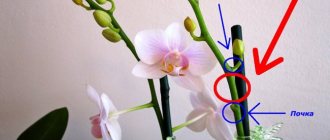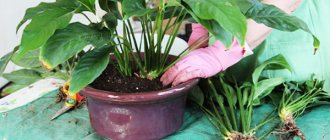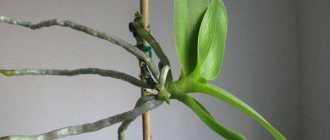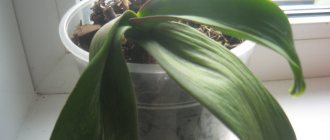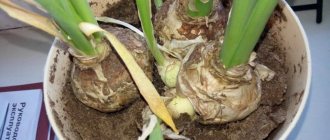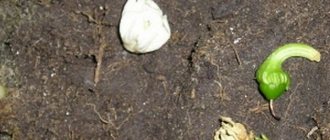Description with photo
The peduncle of this orchid has a sharp tip and a shape resembling a closed beak. It grows from a neck in the center of the leaf and only stretches upward. Next in the photo you can see what the flower stalk of the plant looks like.
Why does it come out but not grow?
First of all, this process indicates insufficient lighting. The amount of light decreases sharply with the onset of autumn, so you need to worry about artificial help. The orchid, in particular the peduncle, reacts very sharply to a decrease in the amount of light. In the best case, the growth of the flower-bearing arrow stops, in the worst case, it dries out completely.
ATTENTION : The reason may also be hidden in a lack of nutrients. The plant may simply not have enough fertilizer. Take care of the comprehensive nutrition of the orchid every two weeks, but not more often, so as not to burn the root system.
How to distinguish from the root or other parts of the orchid?
When the phalaenopsis just begins to develop a peduncle, it can be mistaken for the root or even the baby of the plant, so you need to know how they differ from each other. It can be distinguished from the root by the following characteristics:
- it is necessary to carefully examine the place where the new growth appeared and determine its location relative to the growth point - if it grows from the stem and is located on the root collar between the leaves - this is not a peduncle, but an aerial root;
- the arrow always grows upward, while the roots are slightly inclined downward;
- the color of the roots is greenish-gray and bright green at the tips, while the arrow is monochromatic along the entire length;
- the root is smooth, and the peduncle is divided by small scales;
- the peduncles have a sharp tip, and at the roots it is rounded and blunt.
Differences between the peduncle and the basal child:
- after the baby grows a little, its tip will begin to resemble a boat shape;
- The peduncle grows only from the base of the central vein of the leaf, and the baby, as a rule, grows just above the place of the previous flowering.
We invite you to watch a video on how to distinguish a peduncle from a root in phalaenopsis:
Features of care during the growth period
The period of peduncle growth is a very important moment in the life of an orchid, when it is especially important to provide it with good care.
- It is necessary to provide the plant with good lighting. Daylight hours for a phalaenopsis that has released a shoot should be at least 12 hours. In autumn and winter, you need to place a pot with an orchid on the window sill on the south side of the room, and if this is not possible, you should use a phytolamp for additional lighting.
- Humidity needs to be maintained at an optimal level; for this you can use a humidifier or place a container of water next to the orchid. This is especially important in winter when the indoor air is too dry.
- It is imperative to feed the plant with fertilizers that contain a lot of phosphorus and potassium from the moment the peduncle has just begun to form until the flowers appear on it. After the flowers appear, fertilizing should be suspended, as this will not increase the splendor of flowering, but may provoke a drop of flowers.
- Watering is carried out as usual - as the soil dries out. The regularity is individual for each specific case, as it depends on the temperature and humidity of the air. Phalaenopsis with a regrown peduncle does not need direct spraying; it will most likely destroy the sprout. It is enough to place a flowerpot with an orchid between other plants while spraying them and it will have enough moisture.
Important! Under no circumstances should the soil in the flowerpot be allowed to become completely dry.
Video about caring for phalaenopsis during the period of peduncle growth:
Preventing the problem from recurring
To avoid the recurrence of problems with peduncles, it is necessary to constantly ensure that the plant always has a comfortable environment for growth and sufficient nutrition. It is recommended to use high-quality fertilizer and stimulants that will allow the flower to grow properly.
An orchid is a very delicate and whimsical plant, the cultivation of which requires close attention and careful care. There are several species of this plant, some of which have two or more flower stalks. With proper care, the owner will receive lush buds that will delight the eyes of the owner and guests. Thanks to its charming shape and delicate flowers, millions of gardeners provide the plant with proper care.
Formation period
How quickly does it form?
Let's consider how long the peduncle of an indoor phalaenopsis orchid grows. The average time for its formation in a regular phalaenopsis is two months, in a hybrid one – three. This is exactly how much time must pass after the appearance of the stem before the peduncle is fully formed. If the plant is in comfortable temperature conditions and receives the required amount of light and moisture, then this time will decrease by 1.5-2 times.
The lateral peduncle develops faster - in about 1.5 months.
How many arrows does it fire?
The most common type is phalaenopsis, which has 2-3 peduncles, but there are also specimens with a large number of peduncles. At home, the number of arrows depends on the type of phalaenopsis, its health and the care provided.
The number of buds in an orchid increases under extreme conditions, for example due to temperature changes, drought or an unusually large amount of light.
How to ensure growth?
How to grow a flower stalk? In order to grow it, you first need to make sure that the new growth on the phalaenopsis is actually an arrow. If this is the case, then you need to wait until it reaches a length of 15-20 cm and fix it in a vertical position, tying it to a support in a flowerpot.
It is best to use a special clothespin for this, which can be purchased at any flower shop, but you can also use a regular hair elastic or a small hair clip. If you can’t tie the peduncle to the support, you just need to rotate the pot with the orchid relative to the light.
How to make a released shoot grow upward?
In order for the already blossoming peduncle to grow upward correctly, you need to perform a number of simple steps:
- Make a support.
- Attach any support (such as a stick or plastic tube) to the arrow. It is best to use store supports, which are sticks with a sharp end.
- Next, it must be secured in the middle of the pot without damaging the roots of the plant.
- Add light. With a sufficient light source, the orchid will receive enough strength to grow well and will be drawn to the light source. This will also cause the flower stalks to stretch upward.
- Use stimulants. Stimulants help the plant obtain the necessary substances for active growth.
When using them, the orchid is more likely to be able to produce a slender arrow. There are several types of stimulants: for home and outdoors. It is best to use a general-purpose fertilizer that can be used in both cases. For example, stimulants containing sodium salts of gibberellic acids, which are necessary for the plant.
As it grows, tie the sprout to a support. This technique will help the arrow form correctly, and you will get an impressive-looking flower.
Step-by-step instructions: what to do in a certain situation?
Let's consider what to do if the peduncle that grows from the growth point breaks or other possible cases:
- Grows from a growing point. This happens if the phalaenopsis has already undergone many flowering cycles or has experienced severe stress. In this case, you don’t need to take any action, you just need to take care of the plant and, perhaps, buds or babies will appear on the arrow.
- Broken. In this case, you need to cut the peduncle to the bud located closest to the fracture site and treat the cut site with crushed activated carbon, wood ash or cinnamon powder.
Important! You should not try to glue or connect the fragments in any other way - this will only harm the flower. - Absent at all (you can find out why phalaenopsis does not bloom and how to correct the situation here). You can stimulate the flowering stalk by arranging a slight stressful situation for the plant. To do this, you can, for example, slightly limit the access of light to the flower or water it less often. Of course, it is impossible to bring things to a complete drought. If possible, you can lower the air temperature at night by 5-6 degrees.
- Stopped growing. To begin with, it is necessary to exclude disease or the presence of pests from the list of possible causes. After making sure that the flower is healthy, you should once again reconsider the care of the plant and make sure that it has enough nutrients and moisture, enough light, and that the temperature and humidity levels are comfortable. If the phalaenopsis is not sick and the conditions for keeping it are suitable, but the peduncle still does not grow, you can only wait - if the arrow has not dried out, the orchid can still bloom.
Phalaenopsis has a peduncle growing from its growing point
No, it won’t die, but it won’t bring you new blooms anytime soon!
Under normal conditions, the peduncle of an orchid appears from the axil of the leaf. However, you can often buy an orchid on sale whose peduncle is located exactly at the growing point. These are the so-called instant-forcing or myriclonized orchids.
It is this rosette that will no longer grow after flowering, but it will begin to form children. Babies may appear from under the lower leaves or on the peduncle itself. All we have to do is wait for the children to grow up and bloom.
In rare cases, it happens that the plant forms a new growth point from the axils of the upper ones and begins to grow sideways.
The mother plant with a peduncle from the center of the rosette can produce repeated flowering, but in this case it will give birth to children later. Therefore, it is better to prune it before the end of the first flowering. Pruning is carried out above 2-3 buds, the cut is powdered with ground cinnamon, charcoal powder or treated with brilliant green. Reduce watering to once every 10-12 days.
Between waterings, it is necessary to fertilize the leaves with nitrogen-containing fertilizers.
For the first month, such feeding is alternated with spraying with water with the addition of Zircon or Ribav Extra.
It is also useful to sometimes give the orchid a shower with warm water (40-45 degrees) for 1-2 minutes.
With this care, babies appear in 3-5 months. They are not separated from the mother plant for quite a long time (up to several years) until they grow and become stronger.
If the baby appears on a peduncle, you need to wait until its leaves reach a length of 2-3 cm, then wrap the base of the baby with sphagnum and periodically moisten it with water. This way the baby forms roots faster. When the roots reach a length of about 5 cm, the baby can be separated.
Phalaenopsis quickly gained popularity among indoor plant lovers thanks to its unusual flowers collected in an exquisite inflorescence. This type of orchid is quite easy to care for , and flowering can last from several weeks to several months.
The plant needs special attention during the formation of the peduncle and after the flowers have fallen off.
If simple requirements are met, this flower will delight you with regular, lush blooms.
This article contains everything about phalaenopsis flower stalks: pruning, rooting and other issues.
Peduncle of phalaenopsis
The peduncle of phalaenopsis is a fairly high arrow, at the top of which an inflorescence is formed - a raceme .
The peak formation of flowering arrows occurs in early autumn . At this time, night temperatures begin to differ significantly from daytime ones.
https://www.youtube.com/watch?v=WIaaycTBApI
It usually appears from under the leaf in the form of a small greenish cone. During this period, the flower shoot is easily confused with the developing root, which has a more rounded shape.
Only when the length of the hatched bud is more than 1 cm can you say for sure what kind of shoot it will be - vegetative or flowering.
During the formation of the flower-bearing arrow, phalaenopsis needs special attention:
- At this time, it is better to place the orchid in the brightest place in the room; in the fall it can be a south window;
- The watering regime should be regular as the soil dries out;
- If you fed the orchid before the arrow formed, then this can be continued until the first flower appears.
- the shoot with opening buds is sensitive to air flows from an air conditioner or radiator . If an orchid is left in a draft, it can lose all its buds in one day;
- During the flowering period, phalaenopsis should not be replanted. It is better to place the pot in a decorative transparent flowerpot that matches your interior;
- you can use a special plastic support for support
- At this time, the plant should not be moved to another place or rotated. With a lack of natural light, the arrow will stretch out and the flowers will be faded. In autumn, it is better to install artificial lighting, lengthening the daylight hours to 10-12 hours.
Read also: Treatment of walnut partitions with tincture reviews
Orchids attached to a support.
When growing orchids, beginning gardeners often have questions, the answers to which will help solve a number of problems.
Growing from a cut peduncle
When propagating phalaenopsis from a flowering shoot, the standard cutting method is used. This is done during the period when the plant has faded, but the peduncle remains green and has dormant buds.
So, how to grow phalaenopsis from a cut peduncle:
- before starting work, the pruning shears are treated with alcohol;
- the flowering arrow must be cut to the very base of the rosette and cut into pieces of 3-4 cm. There should be a dormant bud in the center of each cutting;
- the resulting sections are sprinkled with crushed activated carbon;
- cuttings are germinated in a mini-greenhouse filled with damp sphagnum moss at a temperature of +26-28℃.
A humid and warm environment will provide conditions for the rapid formation of babies on cuttings.
According to another method, cut cuttings are placed in water into which mineral fertilizer has previously been added. The container must be placed in diffused sunlight. In about a month, little babies will appear on the cuttings.
Cuttings can also be germinated in a bottle.
Side arrow
A peduncle on a peduncle (lateral flower arrow) may form on a green peduncle several months after the flowers have completely fallen off. After some time, buds will form on it and it will bloom.
To stimulate this process, the green peduncle is cut at a distance of 1 cm above the dormant bud. The closer to the base of the rosette there is a bud above which pruning is done, the more flowers are formed on the side shoot.
Pruning after flowering
Answer to the question “Do I need to trim the peduncle after flowering?” depends on the type of phalaenopsis and how the flowering shoot behaves after flowering:
- changes color, turns yellow and dries;
- partial drying of the flower-bearing arrow is possible;
- The peduncle remains green.
dry, darkened arrows . This is done only after the flowering shoot has completely dried. From the fading peduncle, the plant receives nutrients that have accumulated during flowering. They are necessary for the plant for further recovery and growth.
The dried flowering shoot is cut at a height of about 2 cm from the base of the rosette. After a few months, under optimal conditions, the orchid will form a new arrow.
Read also Buy fertilizers for nymphs
When partially dry, only the dry part of the flowering shoot is removed. It is better not to cut the green peduncle, as after a while it may bloom again.
Stimulating pruning of green flowering shoots can be done in the spring. To do this, it is cut 2-2.5 cm above the dormant bud. This can push the orchid to form a baby.
From the point of growth
The appearance of a peduncle from the growth point means that the phalaenopsis has stopped growing in height and will no longer be able to grow leaves.
Now, in place of the socket, children will form . They can appear from dormant buds in the axils of the lower leaves or on the peduncle itself.
Thus, if the peduncle grows from the growth point, then all that remains is to wait until the children grow a little and I am ready to transplant.
Peduncle from a growing point.
Stimulation of growth
We must remember that in order for a plant to produce a flowering arrow, it needs to create optimal temperature conditions, lighting and care.
If the flower stalk still does not form, there are two simple ways to force the flower stalk to release and bloom profusely:
- reduce as much as possible and sometimes completely stop watering the orchid after flowering;
- create conditions for daily temperature fluctuations from +22-24℃ during the day to 16-18℃ at night.
In the autumn, daylight hours are extended to 12 hours with the help of artificial lighting.
Quantity
Peduncles of orchids are formed from dormant buds in the axils of the leaves. From 1 to 4 flower-bearing arrows can bloom simultaneously on one plant . The main condition on which the number of peduncles in phalaenopsis depends is the species.
Short peduncle
There may be several reasons why the flowering shoot of phalaenopsis grows short
- perhaps this is a specially bred hybrid form;
- after purchase in the store, the growing conditions changed, which affected the development of the unformed peduncle;
- phalaenopsis produces a short peduncle in summer, and a longer one in winter;
- if several flower-bearing arrows have formed;
- from lack of nutrients.
Hybrid phalaenopsis with a short peduncle.
Proper care and growing conditions will guarantee the well-being and lush flowering of the plant.
How to trim correctly?
Phalaenopsis pruning is best done with garden pruners . It injures the plant less than a knife or scissors. Before use, instruments are disinfected with alcohol or immersed in boiling water for several minutes . This will avoid infection and plant disease.
Stopped growing
In some cases, the flower stalk stops growing. If the peduncle has stopped growing, there may be several reasons for this:
- insufficient lighting , sometimes just prolonged cloudy weather. It is better to move such an orchid to a brighter window;
- Phalaenopsis roots have rotted . In this case, phalaenopsis needs to be transplanted;
- sometimes the growth retardation of flowering shoots is due to insufficient watering . Orchid lovers advise covering the surface of the pot with sphagnum moss. This will provide additional moisture and change the acidity of the substrate, after which the peduncle can begin to grow again.
Thus, stopping the growth of the flower-bearing arrow is usually associated with improper care of the plant.
Read also: Grow pomegranates in the middle zone
Growth period
The period of how long the peduncle grows in phalaenopsis, from the appearance of the shoot to the blooming of the first flowers, usually lasts about two months.
Useful videos
The video below shows how the peduncle grows: In this video you can see how to secure the peduncle of an orchid:
-review of various fasteners for phalaenopsis: Watch the video on how to trim an orchid peduncle:
Source: https://bymosque.ru/u-falenopsisa-iz-tochki-rosta-vyros-cvetonos/
What to do after flowering?
What to do with the flowering shoot after the orchid blooms depends on its condition.
- If, after the orchid blooms, the peduncle turns yellow and withers, it should be cut off at the base and the cut should be sprinkled with cinnamon powder, crushed activated carbon or wood ash.
- If only the apical bud dries out, it is better to cut the branch with it to the first lower bud.
- If the peduncle is intact, it has a green tip and dormant buds, then nothing should be done - after a while new flowers may appear on it.
Read more about how to prune Phalaenopsis after flowering here.
We invite you to watch a video about what to do with the peduncle after the orchid has bloomed:
The peduncle is very important for phalaenopsis, therefore, during its growth period, it is necessary to especially carefully care for the plant, and if problems arise, be able to solve them correctly.
How to make several arrows shoot at once at home?
To force an orchid to produce several flower stalks at once, you first need to look at the plant variety. If you buy a flower with one bud, then the likelihood that it will be able to produce several more is extremely small. If you purchased a variety that is capable of producing more than one sprout, then you should follow the rules described above with some amendments.
- Use complex fertilizers. This type of fertilizer is more universal; it is suitable for plants with two or more flower stalks, since growing buds requires a large consumption of resources.
- Decrease in temperature. Some orchid varieties require lower temperatures. Most often, this procedure takes about two weeks, and the temperature should fluctuate in the range of 12-15°. Next, you need to gradually increase the temperature to 18-24°.
